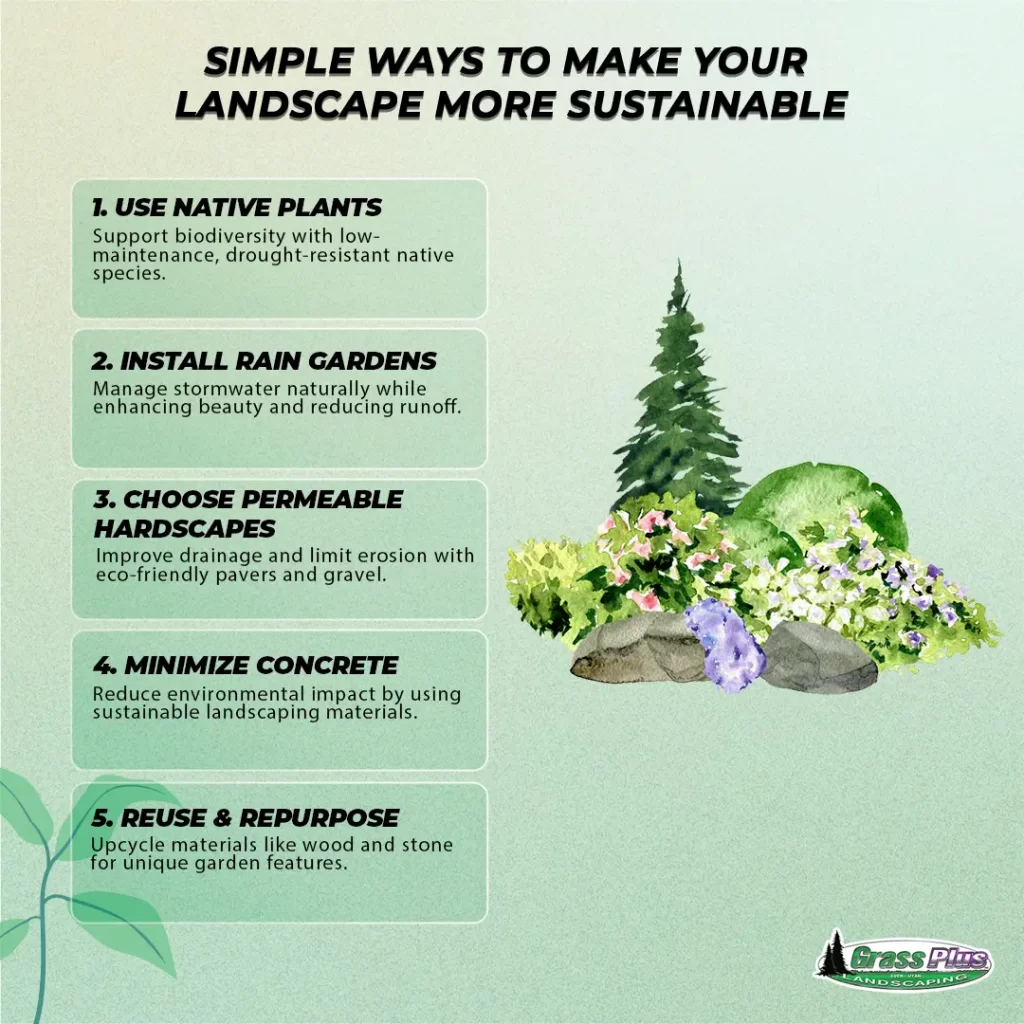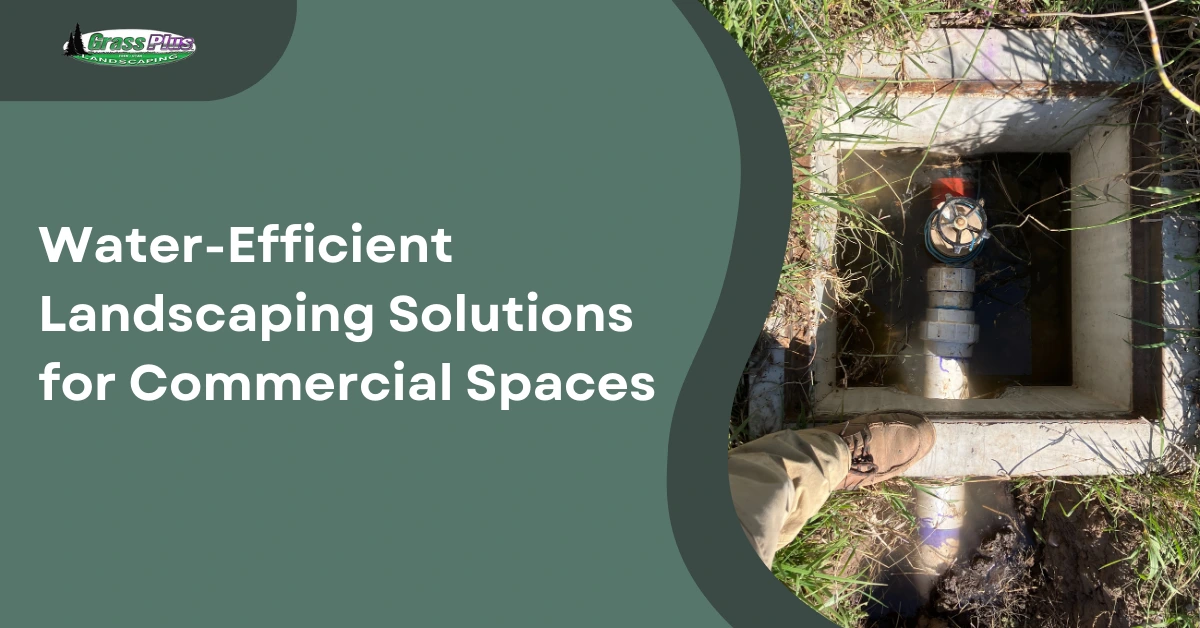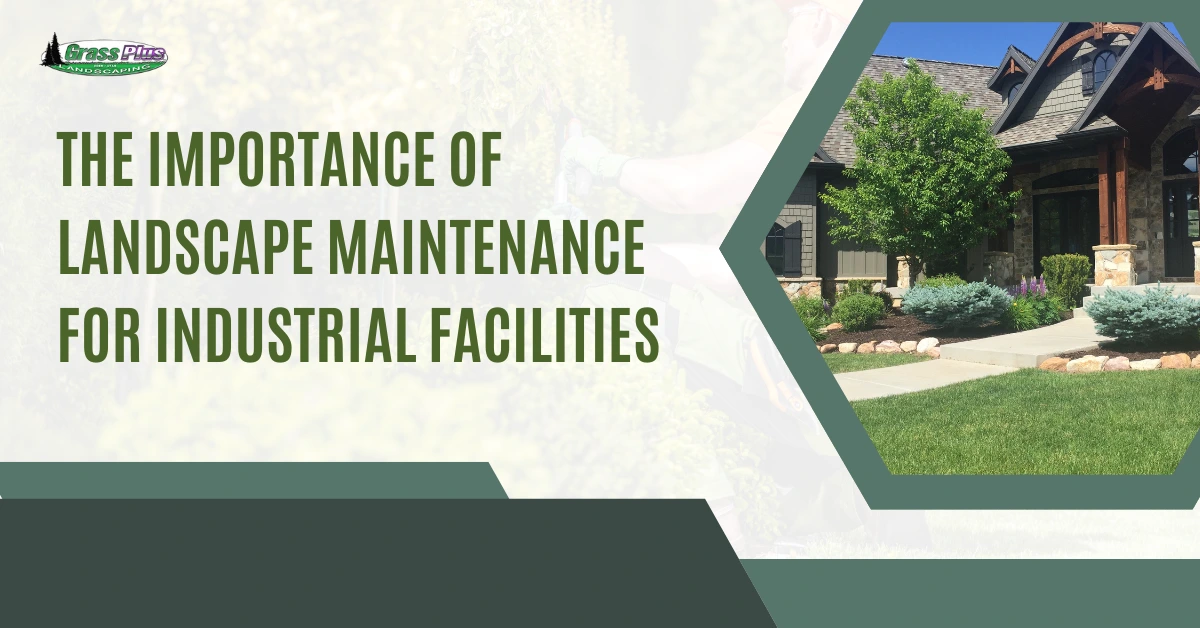For sustainable landscaping, start by using native plants, as they support local ecosystems and require less maintenance. Create a rain garden or bioswale to manage stormwater and enhance biodiversity. Limit concrete usage by opting for permeable hardscapes that allow water absorption. Don’t forget to reuse and repurpose materials to cut waste and personalize your space. These practices not only beautify your yard but also promote environmental health—stick around to discover more effective strategies.

Key Takeaways
- Use native plants to enhance biodiversity, require less maintenance, and promote sustainable landscaping practices.
- Create rain gardens or bioswales to manage stormwater, reduce flooding, and support local ecosystems.
- Minimize concrete in landscapes to enhance water absorption and limit environmental impact.
- Reuse and repurpose materials creatively to reduce waste and add unique features to your garden.
- Implement permeable hardscapes to improve drainage, support groundwater recharge, and enhance landscape aesthetics.
Use native plants
When you choose to use native plants in your landscaping, you’re not just beautifying your space; you’re also supporting local ecosystems. Native plants are well-adapted to your region, requiring less water and maintenance, which makes them a key component of sustainable landscaping. By incorporating these plants, you create a green landscaping environment that thrives without the need for harmful pesticides or excessive fertilizers. This approach helps reduce your ecological footprint and fosters biodiversity, attracting beneficial wildlife like pollinators and birds. Plus, native plants can enhance soil health and prevent erosion, making your landscape more resilient. Overall, choosing native plants is a smart, environmentally-friendly decision that benefits both your yard and the planet.
Create a rain garden or bioswale
Creating a rain garden or bioswale not only enhances your landscape but also plays an essential role in managing stormwater runoff. These features capture and filter rainwater, reducing the risk of flooding and erosion. By integrating them into your property, you’re adopting sustainable landscaping practices that benefit both your garden and the environment.
To start, choose a location where water naturally collects and dig a shallow depression. Fill it with native plants that thrive in wet conditions, promoting biodiversity. This is one of many sustainable gardening methods that improve soil health and attract beneficial wildlife. Regular maintenance, like weeding and mulching, guarantees your rain garden or bioswale continues to function effectively, making it a smart addition to your outdoor space.
Use minimal concrete
Using minimal concrete in your landscaping not only reduces your environmental footprint but also promotes healthier ecosystems. By limiting concrete surfaces, you enhance water absorption, reduce runoff, and support local flora and fauna. Consider alternative materials like permeable pavers or gravel, which can create functional pathways while allowing water to filter into the ground. This approach aligns with sustainable landscape management principles, fostering biodiversity and soil health. If you’re unsure where to start, partnering with a green landscaping company can provide you with expert guidance tailored to your specific needs. They’ll help you design a landscape that balances esthetics and functionality while prioritizing sustainability. Remember, a thoughtful landscape design can contribute positively to your environment.
Reuse and re-purpose whenever possible
Incorporating strategies like reusing and repurposing materials can further enhance your sustainable landscaping efforts. Instead of discarding old bricks, wood, or stones, think about how you can transform them into unique garden borders, pathways, or even raised beds. These sustainable landscaping ideas not only save you money but also reduce waste. You can also repurpose items like pallets for vertical gardens or containers for planting herbs. When considering sustainable lawn alternatives, explore options like clover or native ground covers that require less maintenance and can thrive in repurposed soil. By creatively reusing materials, you’re not just beautifying your space; you’re actively contributing to a healthier environment while showcasing your personal style.
Permeable hardscapes
While many hardscape options can be visually appealing, permeable hardscapes offer a sustainable solution that benefits both your landscape and the environment. These installations allow rainwater to filter through, reducing runoff and promoting groundwater recharge. When you choose permeable materials like pavers or gravel, you’re not just enhancing your outdoor space; you’re also supporting eco-friendly practices.
Working with a sustainable landscaping company can help you design and install these features effectively. Incorporating permeable hardscapes into your green lawn landscaping can improve drainage while minimizing erosion. Plus, they add esthetic value, making your outdoor area more inviting. By opting for permeable solutions, you’ll contribute to a healthier ecosystem and create a beautiful, functional landscape.
Frequently Asked Questions
How Can I Maintain a Sustainable Landscape Throughout Different Seasons?
To maintain a sustainable landscape through the seasons, you’ll want to choose native plants, use organic fertilizers, practice efficient watering, and implement proper mulching techniques. Regular maintenance and seasonal adjustments help guarantee your landscape thrives year-round.
What Tools Are Best for Sustainable Landscaping Practices?
You think you can just grab a shovel and call it sustainable? Think again! For effective landscaping, invest in a quality compost bin, rain barrel, native plants, and efficient tools—your garden (and planet) will thank you!
How Do I Select the Right Native Plants for My Area?
To select the right native plants for your area, start by researching local ecosystems, considering soil type and climate. Visit native plant nurseries and consult local gardening groups for expert advice tailored to your region.
Are There Financial Incentives for Implementing Sustainable Landscaping?
Yes, there are often financial incentives for implementing sustainable landscaping. You might find rebates, grants, or tax credits available through local governments or environmental organizations, encouraging you to adopt eco-friendly practices while reducing your overall costs.
How Can I Educate Others About Sustainable Landscaping Practices?
You can educate others by hosting workshops, sharing informative articles, or creating engaging social media content. Encourage discussions, provide resources, and showcase successful projects to inspire your community to embrace sustainable landscaping practices.
Conclusion
By embracing these best practices for sustainable landscaping, you’re not just planting a garden; you’re creating a lush paradise that attracts butterflies, sings with birds, and whispers to the wind! Each native plant you choose transforms your yard into a vibrant ecosystem, while rain gardens dance with droplets, and permeable paths invite nature’s embrace.Picture a world where your outdoor oasis flourishes effortlessly, making a positive impact on the planet with every vibrant bloom. Take the eco-friendly route – you’re capable of making a difference!





